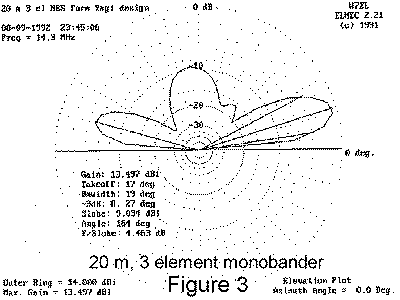


 |
A three-element Yagi will outperform a dipole by 8 dB. That's what the books say, give or take a couple of dB. When I was new to ham radio, life was simple, gear was simple. I used government surplus radios, folded dipoles, and worked CW. Eventually, I graduated to a 100 watt SSB transceiver. I was still using dipoles. In the early sixties, linear amplifiers were dreamed-of accessories, not the necessity they are today. Most of my local friends used equipment similar to mine. A couple of nearby hams had beams. There was even a linear or two around, but there wouldn't be one at my house for several years. It was during those early years in ham radio, that I observed a very curious phenomena. It seemed as though stations using beams always got great signal reports and they could hear stations that were in the noise or QRM for me. I knew that a beam was supposed to have around 8 dB gain over my dipole, but it wasn't often that my signal reports were within an S-unit or two of the guys with the beams. In those days, there was simply something mysterious about those collections of aluminum that graced the tops of towers in other ham's back yards. I didn't know exactly what the difference was, but I did know that beams had a big advantage. This lead me to believe that one of two things was happening. Either signal reports were being inflated, or there was actually more than an 8 dB difference between dipoles and beams. Figures 1 through 4 give us one explanation for the difference in signal strength between my dipole and my neighbor's beam. First, let me tell you what these figures represent. Figures 1 and 2 are the azimuth and elevation patterns of a 20 meter dipole 50 feet in the air. Figures 3 and 4 represent a 3 element, 20 meter monobander also 50 feet high. The dimensions for the 3 element monobander were taken directly from the book Yagi Antenna Design by Dr. James L. Lawson, W2PV, page 7-2. This Yagi is based on NBS standards. I made no attempt to modify or optimize antenna dimensions, and as you can see, the front-to-back ratio is poor. For this article, it doesn't make any difference. That said, the beam is obviously designed for maximum gain and not maximum front-to-back ratio. The height of both antennas is .75l or about 50 feet, a common height for amateur radio antennas. Figure 3 shows that the beam's radiation pattern is concentrated at a low takeoff angle of 17·. This is an excellent takeoff angle for working DX. The dipole in figure 1 also has a low takeoff angle of 19·, but this lobe is very narrow. A much larger secondary lobe points straight up into the sky and a lot of energy is wasted warming the clouds. At all other directions, the difference between the dipole and beam would be between -6 dB and -20 dB, perhaps more. |